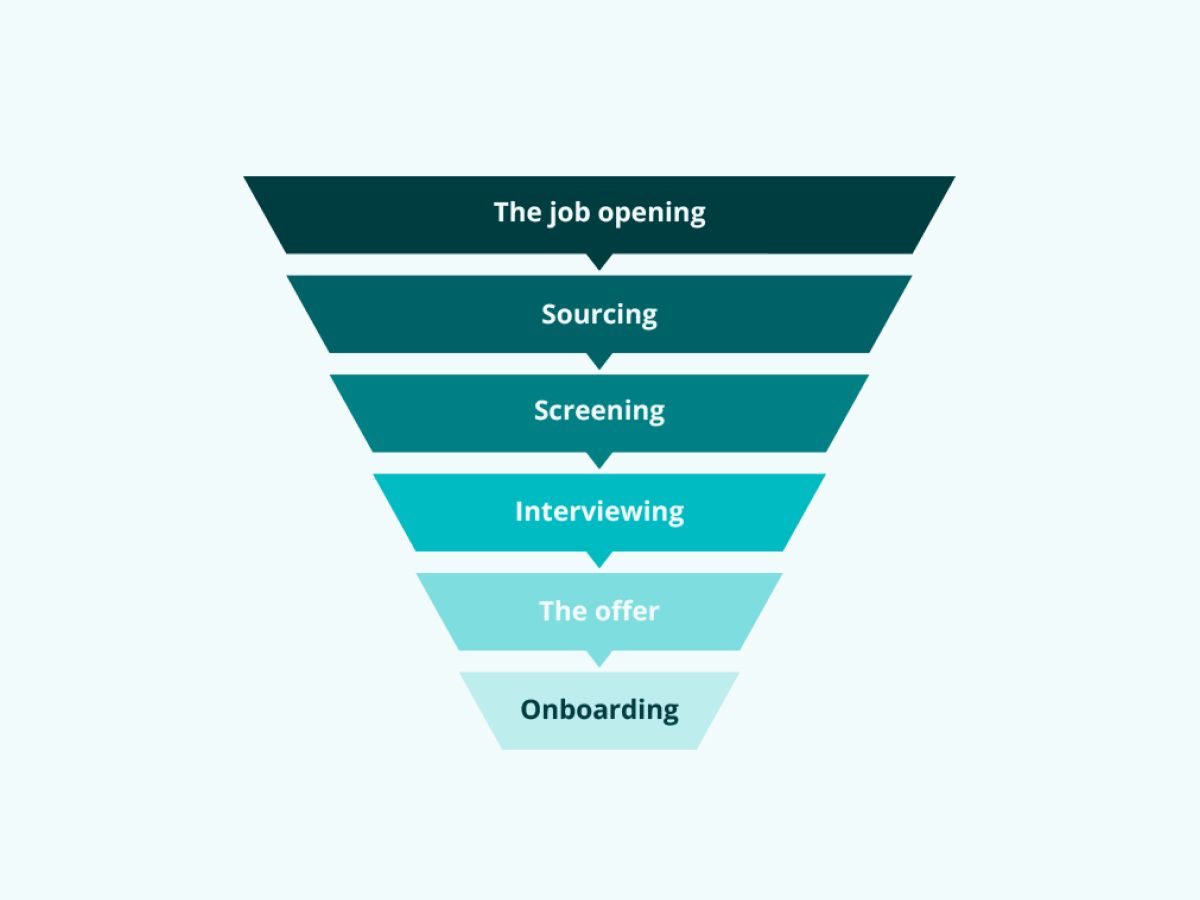Candidate Resources
11.30.2022
The technical hiring process explained

Jason Wodicka


- It’s 2022, you’re a software engineer, and you’re looking for technical work. If this describes you, you’re not alone. The good news is that openings in tech still exist. However, there’s one big step between today’s you and the you who is building interesting things and getting paid for it: you need to get hired in a tech position.
That’s what we do at Karat: we’re working to improve that process, while making it more fair and equitable, to unlock the opportunity for more people to work in tech. Here, we’re going to break down and unpack the hiring process, so you can approach it with more confidence, and hopefully find your own place in a technical career.
Hiring from both sides of the desk
As an aspiring job-seeker, the hiring process can be confusing and stress-inducing. You need to create a résumé, follow all sorts of contradictory advice, and then submit it to companies with the hope that one will call you back. When they respond, you need to navigate a series of high-stakes conversations with people who will ultimately decide whether or not they want to invite you to work with them.
The truth is, it’s not much better for the people doing the hiring. When recruiting for a technical opening, there are often hundreds of applications and résumés to sort through and decide who to contact. If you interviewed everyone who applied, you’d spend so much time interviewing that nothing would get built. Conversely, there’s no simple way to review someone’s application and immediately know if they’re right for the job. You want to hire someone to help your team go further – but how do you find the right person?
Both participants in this process have a common goal: they want to put a qualified person in a role where they will succeed! The difference is that as an applicant, you’re focusing on situations in which you can be that person, while the hiring company is focusing on situations in which one of their roles is filled. When you get hired, that’s a victory for you and the team you will be joining.
When we look at hiring this way, it’s easier to see why it’s useful to understand what the other party is trying to accomplish. But much of the hiring process happens behind closed doors, making it hard to understand the big picture. Let’s start by shedding some light on what happens in a typical company hiring process for technical positions.

The technical hiring process
This is an overview of a typical hiring process – we’ll return to these topics in future articles and dig deeper, and go into more detail about what can happen in each step and how it affects you. But first, let’s take a quick tour of the whole journey to see how the pieces fit together.
The job opening
Everything in the hiring process starts with a need. There are things to do, and there aren’t enough people to get them done. Typically, a manager will identify a need or opportunity – a place where today, something isn’t getting done, or something new and valuable could be accomplished with more people – and then they’ll create a job description for the kind of person they imagine doing that work well. That job description is a summary of their ideal employee — the person they’d hope to hire in a perfect world. It might turn out to be an accurate reflection of who they’ll end up hiring, but it’s likely to get refined during the hiring process, as interviewing applicants reveals what actual candidates are like.
Sourcing
Simply stating you want to hire someone isn’t usually enough to attract the right people. After a job is posted, the work of sourcing begins. Sourcing is the process of finding people who might be right for the role and convincing them to apply. Companies use a variety of methods to source candidates, including posting advertisements on job boards, reaching out to people directly, requesting referrals from people they know, partnering with organizations that assist job seekers, and more. The common factor is that they’re looking for candidates who they think might succeed in the process. Once they’ve found a strong pool of candidates, they move them forward to the next step.
Screening
The goal of sourcing is to find a wide pool of viable applicants. The purpose of screening is to focus on those who are most likely to succeed. When screening technical talent, there are two major techniques, used together:
Résumé screening looks for candidates who have the right amount of experience, and job-relevant skills listed on their résumé. This helps filter out applicants who misunderstood the job posting, or those who applied without the necessary qualifications. Many companies are trying to reduce the extent that they rely primarily on résumés when evaluating applicants, because it may hurt applicants from non-traditional backgrounds.
Skill assessment looks for candidates who can directly demonstrate the skills that are relevant to the position. The principle is intuitive: asking candidates to program during the interview process will demonstrate that they have the skill required for a programming position. There are many forms of skill assessments, but all of them involve the candidate doing job-related tasks in a way that the hiring company can evaluate.
Other forms of screening may also be used to check for obvious issues that would prevent the candidate from succeeding, checking for things like the ability to work in the country where the role is, or willingness to relocate for roles that are tied to a particular location. These are straightforward, and it’s generally obvious to both the candidate and recruiter when there’s a mismatch.Interviewing
Of course, screening alone can’t provide enough information to make an informed hiring decision. Candidates who do well in screening are invited to do further interviews. A few short years ago, these were often called “on-site” interviews. This term is still in use, but with the mainstreaming of remote work, many companies are now conducting their entire interview process by video conferencing. Whether in-person or remote, the interview process is a significant time investment for both the applicant and the hiring team, so companies reserve it for candidates who seem likely to succeed.
The technical interview process generally includes a deeper assessment of the candidate’s technical skills than a screening, as well as behavioral questions that probe their interpersonal and organizational skills. Modern software development is a team sport, and most companies are looking for candidates who have both technical capabilities, and the skills to collaborate with others. The interview process is also where the candidate gets their best impression of the company, talking with multiple current employees, and often meeting many of their potential direct teammates.
There’s a lot to cover in the interview process, and we’ll revisit it in future articles.
The offer
When everything goes well for both the applicant and the company, the process moves forward toward its final step with an offer. At this point, the company is confident in what the candidate is bringing to the relationship, and the decision moves to the candidate to determine whether the role is right for them – or, if a candidate has multiple offers, which role is right for them. In making that decision, financial details of the offer are important, but so are qualitative aspects of the role, including company culture, career growth, and the nature of the work. During this phase, it’s common for the recruiter, the hiring manager, or other team members to reach out to the candidate, to help resolve concerns and demonstrate their interest.
Onboarding
The final step in the hiring process happens after an offer is accepted and signed, and the candidate joins the company as a new member of the team. In technical fields, complexity is everywhere, and it’s rare to start a new role and be productive on day one. The first weeks and months in a new role are the final stage of hiring, as the newly-hired team member and the rest of the team collaborate to develop the specialized knowledge and skills needed in this particular role. Technical onboarding is an investment the hiring team makes in their new colleague.
The job opening that launched the hiring process is also a marker of when it’s complete – not when the new hire joins, but when they begin making their own contributions to the need that first created the job.
The end of the tour
That’s an overview of the hiring process, in six general steps. Of course, there’s a lot of detail we’ve had to omit, and every company has variations in the particulars of how they choose to conduct these steps. We’ll explore individual aspects of the process in more detail in future articles, and discuss some of those variations.
While we’ve covered a lot of ground, there are a few key points that it helps to remember:
- The hiring process starts with a broad search for potential qualified candidates, then filters to focus on those applicants that are most likely to succeed in the role.
- The candidate and the company both want the same thing: a successful hire, in a role where they will do well.
Additional technical hiring resources
Related Content

Candidate Resources
02.28.2023
We celebrate Black Brilliance throughout the year, but this month has been exceptionally special for us as we have highlighted Black leaders and candidates within the Karat community. Rounding up Black History Month, we’d love to shed more context on a few candidates who landed job opportunities through Brilliant Black Minds. Yosief Kidane, Isaiah Smith, and Victor Pimentel […]

Candidate Resources
04.18.2022
My name is Darius Faison, and I’m a senior at Morehouse College graduating this spring. I’ll be starting as a software engineer at Microsoft this summer in Atlanta, Georgia. But trust me, my journey wasn’t at all linear. This is my story about the power of practice and Brilliant Black Minds. Growing up, I was […]

Candidate Resources
03.04.2021
Anthony Mays didn’t know he’d be here. Growing up a Black kid in Compton in the 1980s and 90s, there weren’t Black technologists, futurists, and engineers to look to for inspiration. He and his family were just trying to remain resilient and encouraged in an environment where poverty and pain were far too common. Years […]